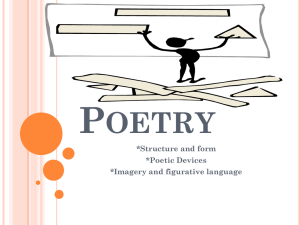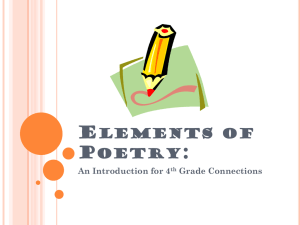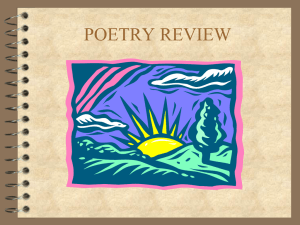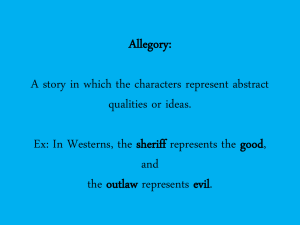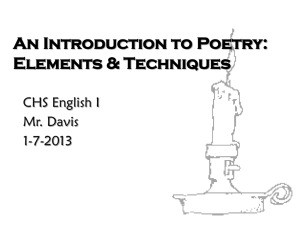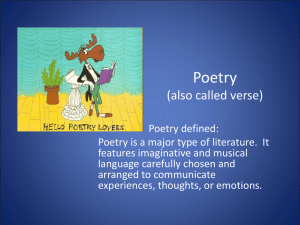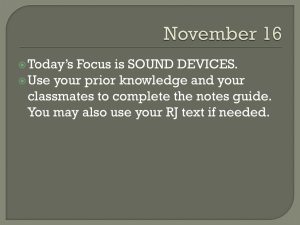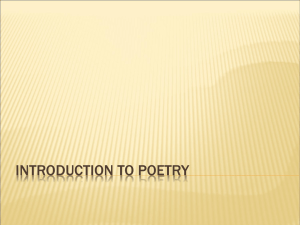The Qualities of Poetry
advertisement
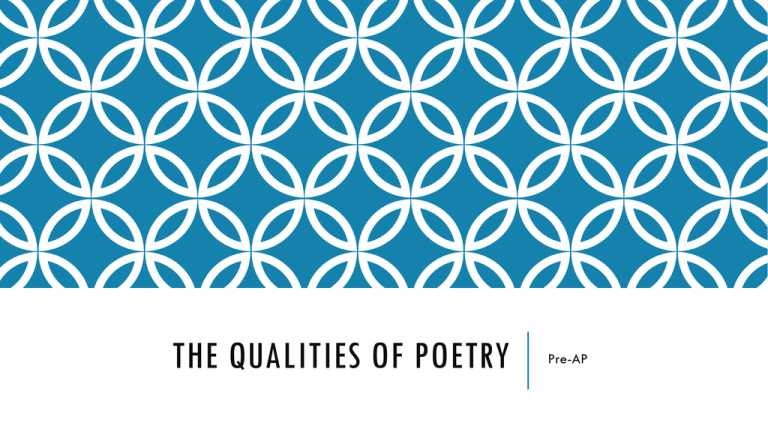
THE QUALITIES OF POETRY Pre-AP POETRY “Are words arranged in a rhythmic pattern with regular accents (like beats in music), words which are carefully selected for sound, accent and meaning to express, imaginatively, ideas and emotions. Each poem has rhythm, melody, imagery, and form” SUBJECT VS. THEME SUBJECT MATTER, simply put, is the person, place, object or item about which the poem is written. THEME is more challenging, it is the moral lesson to be drawn from the poem. This is usually foreshadowed by the title and opening verse, however may require closer examination of the conflict and resolution to truly discover deeper meaning. Remember, sometimes theme is abstract or implied rather than stated. FORM The basic unit of poetry is the line. It serves the same function as the sentence in prose, although most poetry maintains the use of grammar within the structure of the poem. Most poems have a structure in which each line contains a set amount of syllables; this is called meter. Lines are also often grouped into stanzas. The stanza in poetry is equivalent or equal to the paragraph in prose. Often the lines in a stanza will have a specific rhyme scheme. Some of the more common stanzas are: Couplet: a two line stanza Triplet: a three line stanza Quatrain: a four line stanza Cinquain: a five line stanza Meter is the measured arrangement of words in poetry, the rhythmic pattern of a stanza, determined by the kind and number of lines. Meter is an organized way to arrange stressed/accented syllables and unstressed/unaccented syllables. Whose woods / these are / I think /I know Rhyme is when the endings of the words ‘sound’ the same. Read the poem below: Dust of Snow by Robert Frost The way a crow Shook down on me The dust of snow From a hemlock tree Has given my heart A change of mood And save some part Of a day I had rued. Rhyme scheme is the pattern of rhyming words at the end of each line. Not all poetry has a rhyme scheme. They are not hard to identify, but you must look carefully at which words rhyme and which do not. Dust of Snow Poems of more than one stanza often repeat the same rhyme scheme in each stanza. by Robert Frost A B A B C D C D The way a crow Shook down on me The dust of snow From a hemlock tree Has given my heart A change of mood And save some part Of a day I had rued. FORM CONT. Generally speaking, poetry can be of either fixed or free form. Fixed form is a poem that may be categorized by the pattern of its lines, meter, rhythm, or stanzas; a style of poetry that has set rules. Ex: sonnet, villanelle, limerick Free Form (free verse) is a poem that has neither regular rhyme nor regular meter. Free verse often uses cadences (A falling inflection of the voice, as at the end of a sentence) rather than uniform metrical feet. FIXED FORM Fixed form poems come in many shapes and sizes but some of the more well known examples include: sonnets, haiku, cinquain, limericks and even monologues. Cinquain: a poem with five lines Line 1 is one word (the title) Line 2 is two words that describe the title. Line 3 is three words that tell the action Line 4 is four words that express the feeling Line 5 is one word that recalls the title Tree Strong, Tall Swaying, swinging, sighing Memories of summer Oak NOW IT’S YOUR TURN!! Create your own Cinquain and share it with the class. Time – 7 minutes. FREE FORM OR FREE VERSE A free form poem is literary piece that has no restrictions in terms of how it is organized. Unlike conventional poems it has no specific rhythm, structure, metre and measure. Free form poems are based on exactly what their name or title implies. Washed Away by Katherine Foreman Nothing's changed except me and the facts And the sadness I didn't mean to start. But it feels different now you've said It's wrong, and I still can't see your point. And I think as water runs over my hands that That's really all there is or can be. The gold is wearing off the infamous ring And something wears away from around my heart. HOMEWORK TASK For tomorrow’s class, I want you to write a ten line free form poem about a subject of your own choosing. Select something that you are passionate about and/or upsets you. You may be asked to share your poem with the class. TONE AND ATMOSPHERE Writers generally have some feelings about their subjects and sometimes these feelings are immediately evident, we call this tone. Tone is the manner in which a poet makes his statement; it reflects his attitude toward his subject. Since printed poems lack the intonations of spoken words, the reader must learn to "hear" their tones with his mind's ear Similarly, atmosphere is more of a general feeling that surrounds the poem. It is established through setting and diction (author’s choice of words). RHYME Rhyme is the repetition of similar sounds in two or more words. In poetry, these words are usually at the end of a line “end rhyme” and help create a certain rhythm. For example tree, me, see, be, flee all rhyme because they end with the same sound. Rhyme Scheme is the pattern in which rhyming happens. For example, There once was a big fat cat, a That liked to eat cute little mice. b All day he watched while he sat, a For those mice that tasted so nice. B Cat and sat rhyme, as well as mice and nice. So, the rhyme scheme is a, b, a, b. RHYTHM Rhythm (or "measure") in writing is like the beat in music. In poetry, rhythm implies that certain words are produced more force- fully than others, and may be held for longer duration. The repetition of a pattern of such emphasis is what produces a "rhythmic effect." The word rhythm comes from the Greek, meaning "measured motion." In speech, we use rhythm without consciously creating recognizable patterns. For example, almost every telephone conversation ends rhythmically, with the conversants understanding as much by rhythm as by the meaning of the words, that it is time to hang up. Frequently such conversations end with Conversant A uttering a five- or six-syllable line, followed by Conversant B's five to six syllables, followed by A's twoto four-syllable line, followed by B's two to four syllables, and so on until the receivers are cradled. Well I gotta go now. Okay, see you later. Sure, pal. So long. See you. Take care. Bye bye. Bye bye. RHYTHM CONT. The most obvious king of rhythm is the regular repetition of stressed and unstessed syllables found in some poetry. The most common units ("feet") of rhythm in English are: The iamb, consisting of two syllables, only the second accented (as in "good-bye") The trochee, two syllables, only the first accented (as in "awful") The anapest, three syllables, with only the third stressed (as in "Halloween") The dactyl, one stressed syllable followed by two unstressed (as in "wonderful") The spondee, two consecutive syllables that are both stressed (as in "big deal") IMAGERY To conjure images in a reader’s mind, poets frequently compare both similar and dissimilar objects or states of mind. It can be directly stated like a “bird swooping in like a thunderbolt” or may be spoken of as though it were another. For example, talking about the eagle as though it were a person, “he clasped the crag with crooked hands”. Authors also try to invoke the readers senses, as imagery depends upon it – They appeal to: Touch (Tactile) Taste (Gustatory) Smell (Olfactory) Sound (Auditory) or Sight (Visual) WHAT DO I LOOK FOR Generally speaking, when we read poetry we try to: 1. Hear the words – rhyme, rhyme scheme, new words or expressions (neologism) and poetic devices like alliteration, assonance, onomatopoeia etc. 2. Look at the words – diction: connotation vs. denotation, enjambment, meter, flow of the language etc. 3. Look at the big picture (structure) – lines, stanzas, punctuation etc. UNDERSTANDING THE POEM You will be introduced to the TPCASTT method of analysis when it comes to poetry, but here are some tips to help you: 1. 2. 3. Read the poem slowly and out loud to help hear the “musicality” of the poem. Be patient, for poems can be ambiguous or confusing. Talk about it with others who have read it, when possible. Read the poem several times.
